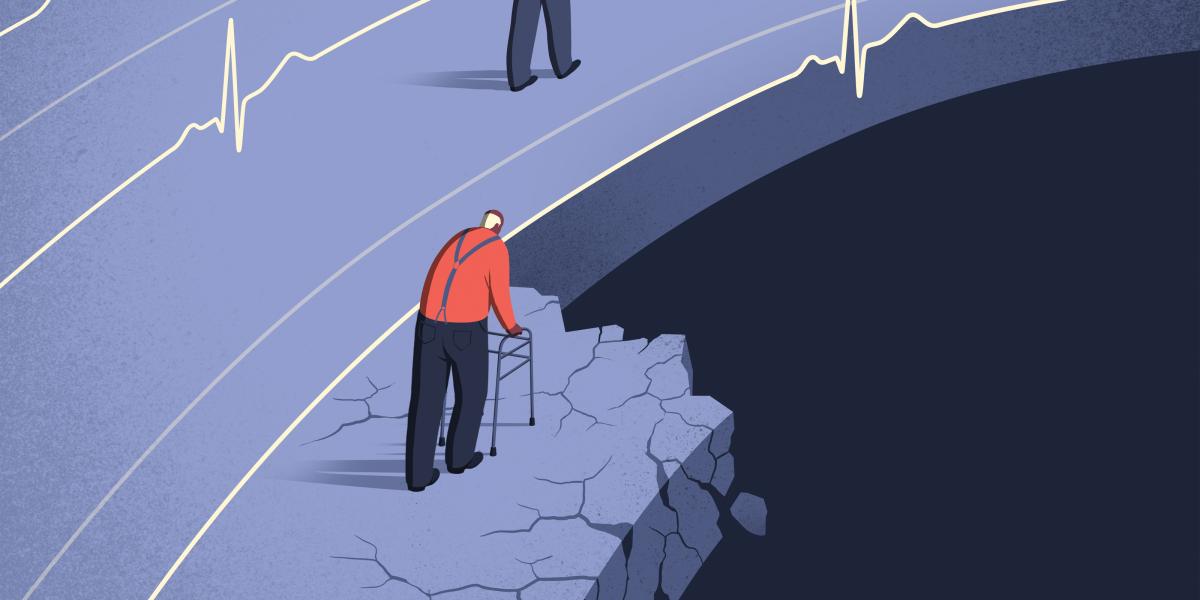Reducing Racial Disparities in Dementia
Step one in closing the gap: Measure the impact of structural racism.
During a 2010 lecture to Johns Hopkins undergrads about cultural factors in public health, Roland Thorpe Jr. showed a slide of life expectancies for Black and white men and women from 1900 to 2006. It was not new data to Thorpe, but seeing it that day on the big screen had an impact.
“What was shocking to me is that African American men always had the lowest life expectancy, [ever] since data has been collected,” he recalls. “That really made me think, why is that the case?”
Black men in 1900 were expected to live 32.5 years compared to 46.4 years for white men. Over a century later, the life expectancy for Black men is 69.1 years versus 75.1 years for white men, according to CDC 2022 life expectancy data. Black men also have a higher prevalence of chronic disease and are twice as likely to develop Alzheimer’s disease and Alzheimer’s disease related dementias.
Thorpe, PhD, MS, a professor in Health, Behavior and Society and senior associate with Johns Hopkins Center on Aging and Health, is now focusing on those latter disparities. As part of a team researchers from the Bloomberg School, the Johns Hopkins School of Nursing, and Columbia University Mailman School of Public Health, Thorpe is working on an NIH-backed study to understand the role of structural racism in disparities in dementia prevalence and outcomes.
The goals of the study, Reducing Dementias (AD/ADRD): Addressing Structural Discrimination and Resilience, are ambitious. Led by principal investigator Sarah Szanton, PhD, MSN, dean of the Johns Hopkins School of Nursing with appointments in the School of Nursing and in Health Policy and Management, the study aims to develop a measure of structural racism and resilience, use that measure to predict outcomes in AD/ADRD, and to erase the disparity in prevalence.
“Creating a measurement of structural racism is imperative to conducting high-quality research on it—and dismantling it,” Thorpe explains.
Structural racism encompasses systems and institutions including education, housing, health care, employment, and more—and how they interact to advance racist policies, practices, and beliefs. The definition has evolved over time, Thorpe and co-author Lorraine Dean, ScD, explain in a 2022 American Journal of Epidemiology article that traces research on the topic.
Previous studies on structural racism and health have tended to focus on the connection between a single domain, such as segregated neighborhoods, and health. “What’s missing is a precise definition of structural racism and a life-course perspective,” Thorpe says.
To address those gaps, the AD/ADRD study team is mapping nine domains of structural racism including housing, education, employment, earnings, and other discriminatory systems, from birth to older adulthood. Each domain is complex, and they are interconnected.
“Neighborhood is just one domain of structural racism, but it can affect the quality of the schooling, the quality of the air and water … and whether people have access to green space or healthy food,” Szanton explains. Street layout, walkability, and social cohesion contribute to health outcomes, as do policing and discriminatory housing policies like redlining.
Nearly three decades ago as a home-health nurse in West Baltimore, Szanton witnessed how overlapping structural inequities affected her patients’ aging process. Some elderly patients greeted her at the door, while others threw their housekey down from the bedroom window because they couldn’t walk down the stairs. What struck her—and inspired her subsequent research—were the factors beyond her patients’ immediate health concerns.
For example, she saw major health differences even for people who had worked in the same field. The retired janitor with good health care access and a retirement plan had better health and well-being than the housekeeper who retired without benefits. “The ones with pensions and good care could access medication and specialty care more easily,” Szanton explains. “This was a structural reason they had different health.”

Karen Bandeen-Roche, PhD, MS, a professor in Biostatistics and co-director of the Johns Hopkins University Claude D. Pepper Older Americans Independence Center, brings nearly a decade of pioneering research on frailty to the project. In a 2015 study on the epidemiology of frailty, Bandeen-Roche and collaborators found a 60% to 80% greater prevalence of frailty among older Black and Latino adults. “The most stunning finding was the very large disparities in frailty by race and ethnicity, far more striking than any other finding,” she says.
In 2021, Bandeen-Roche, Thorpe, and others published a subsequent study exploring racial/ethnic disparities in frailty. “We studied whether those disparities could be explained away by poorer health or by income disparities,” Bandeen-Roche says, but the answer was “absolutely not.”
“This opened the hypothesis that it is the experience of racism that really sustains disparities in health and aging,” she says.
Proving that—and ultimately eliminating health disparities caused by structural racism—requires a valid measure of structural racism. Paris “AJ” Adkins-Jackson, PhD, MPH, assistant professor of Epidemiology and Sociomedical Sciences at the Mailman School, brings expertise as a psychometrician to this part of the study. She also brings personal experience with the generational significance of what the team is studying.
“While I might not have been alive for some of the ugliest parts of our history, my grandmother, who has dementia, has been alive for that, and that impacts how she has raised me, the lessons she taught me, and the fear she had, so it ripples and continues to impact the present,” she says.
In a 2022 American Journal of Epidemiology article, Adkins-Jackson and co-authors offer several recommendations for measuring structural racism, including using mixed methods and considering exposures in terms of time, history, and life course—which the NIH study has done from the start.
To create their measurement, the team started by conducting oral histories of older Black adults, examining the nine domains of structural racism’s across a person’s lived experiences. For aging people of color, teasing out history’s impact on health is essential. What a person recalls of the infamous U.S. Public Health Service Untreated Syphilis Study at Tuskegee, for example, gives insight into how willing Black men are to engage in the health care system and research studies, Thorpe says.
Combining oral histories with publicly available data—some 70,000 census surveys, voting wait times, ZIP codes across the lifespan, and more—can further illuminate the effects of structural racism on health. Aisha Dickerson, PhD, MSPH, an assistant professor in Epidemiology, is examining the neighborhood domain, specifically the complex environmental issues in communities where study participants live.
“Black men are often segregated into neighborhoods with more air pollution exposure, high-traffic roads, and industrial facilities”—all of which increase inflammation, stress, and exposure to fine particulate matter, which is linked to dementia risk, Dickerson says.
The “wealth-health” gradient casts a haze over the deeper causes. Some industrial companies are attracted to the lower property values and cheaper land in racially segregated neighborhoods. Today, 70% of Superfund sites, severely contaminated industrial sites as determined by the U.S. EPA, are within a mile of federally funded housing.
“What we’re trying to do is restorative, to document the stories that have been lost, forgotten, or ignored, to explain how to help them in the present,” Adkins-Jackson says. “Without that documentation, we cannot get to a place of healing."
A tool that will allow researchers to measure directly the impact of structural racism has enormous potential. “The raw ingredients we’re using to make our measure—for example, place of birth, place of primary school, and place of midlife—could be included in other studies,” Szanton explains.
Adding this data could be a game-changer for research on hypertension, kidney disease, heart disease, cancer, life expectancy, and disability, Bandeen-Roche adds. “Future studies would only require participant residence address information, which links to the publicly available information from which [our] measure is created,” she says. “Then, the impact of lived experience on older adult health could be unpacked from the crude ‘race/ethnicity’ label that has historically anchored disparities research.”
A proven risk-prediction tool will also improve prevention, diagnosis, and treatment for strokes, brain tumors, Parkinson’s disease—all of which can cause AD/ADRD.
Longer term, the team hopes that their work measuring structural racism’s impact on health outcomes will inform efforts by researchers, clinicians, and policymakers alike to improve health and aging for people of color—by ultimately dismantling structural racism.
“The goal,” says Thorpe, “is to leave society a better place than we found it, with research.”
